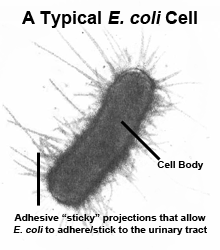 There is evidence that D-Mannose may help prevent or even treat urinary tract infections caused by E. Coli. It has been suggested that uropathogenic strains of E. coli may adhere to (and thereby infect) human uroepithelial cells by binding to mannose residues on cell surface molecules. Numerous strains of gram negative bacteria adhere to animal cells and this adherence can be inhibited by D-Mannose. It is hypothesized that D-mannose is excreted in the urine, where it binds E. coli, thereby preventing the organisms from adhering to the bladder wall and causing them to be eliminated during urination. Another possible explanation for the efficacy of D-mannose is its relationship to Tamm-Horsfall protein. This glycoprotein, which is produced by renal cells and excreted in the urine, plays a key role in the body’s defense against UTIs. Tamm-Horsfall protein contains a large number of high mannose structures, which appear to account for its infection-fighting activity.
There is evidence that D-Mannose may help prevent or even treat urinary tract infections caused by E. Coli. It has been suggested that uropathogenic strains of E. coli may adhere to (and thereby infect) human uroepithelial cells by binding to mannose residues on cell surface molecules. Numerous strains of gram negative bacteria adhere to animal cells and this adherence can be inhibited by D-Mannose. It is hypothesized that D-mannose is excreted in the urine, where it binds E. coli, thereby preventing the organisms from adhering to the bladder wall and causing them to be eliminated during urination. Another possible explanation for the efficacy of D-mannose is its relationship to Tamm-Horsfall protein. This glycoprotein, which is produced by renal cells and excreted in the urine, plays a key role in the body’s defense against UTIs. Tamm-Horsfall protein contains a large number of high mannose structures, which appear to account for its infection-fighting activity.
Over 20 years, it has been observed that treating UTIs caused by E. coli with D-mannose has an efficacy rate of 85-90%. In addition to being an effective treatment for UTIs, D-mannose can prevent post-intercourse UTIs and is also effective for prophylaxis in women who are prone to recurrent UTIs. D-mannose is available as a powder and can be mixed in a glass of water of juice. Doses are 1 teaspoonful (about 2 gm) for adults and ½-1 teaspoonful for children every 2-3 hours. Treatment should be continued for 2-3 days after symptoms have disappeared. For preventing recurrent UTIs, patients should start with the dosages listed above and then reduce the dose. For prevention of post-intercourse UTIs, the recommended dose is 1 tablespoonful 1 hour prior to intercourse and again immediately afterwards. D-mannose is not effective for UTIs caused by organisms other than E. coli.
In good health,
Lucinda
P.S. — You can find out more about one of our D-Mannose products here.
